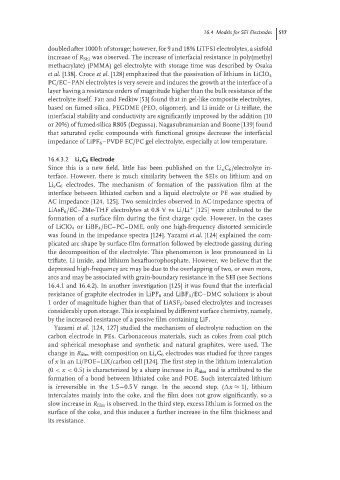Page 544 - Handbook of Battery Materials
P. 544
16.4 Models for SEI Electrodes 517
doubled after 1000 h of storage; however, for 9 and 18% LiTFSI electrolytes, a sixfold
increase of R SEI was observed. The increase of interfacial resistance in poly(methyl
methacrylate) (PMMA) gel electrolyte with storage time was described by Osaka
et al. [138]. Croce et al. [128] emphasized that the passivation of lithium in LiClO 4
PC/EC–PAN electrolytes is very severe and induces the growth at the interface of a
layer having a resistance orders of magnitude higher than the bulk resistance of the
electrolyte itself. Fan and Fedkiw [53] found that in gel-like composite electrolytes,
based on fumed silica, PEGDME (PEO, oligomer), and Li imide or Li triflate, the
interfacial stability and conductivity are significantly improved by the addition (10
or 20%) of fumed-silica R805 (Degussa). Nagasubramanian and Boone [139] found
that saturated cyclic compounds with functional groups decrease the interfacial
impedance of LiPF 6 –PVDF EC/PC gel electrolyte, especially at low temperature.
16.4.3.2 Li x C 6 Electrode
Since this is a new field, little has been published on the Li x C 6 /electrolyte in-
terface. However, there is much similarity between the SEIs on lithium and on
Li x C 6 electrodes. The mechanism of formation of the passivation film at the
interface between lithiated carbon and a liquid electrolyte or PE was studied by
AC impedance [124, 125]. Two semicircles observed in AC-impedance spectra of
LiAsF 6 /EC–2Me-THF electrolytes at 0.8 V vs Li/Li [125] were attributed to the
+
formation of a surface film during the first charge cycle. However, in the cases
of LiClO 4 or LiBF 4 /EC–PC–DME, only one high-frequency distorted semicircle
was found in the impedance spectra [124]. Yazami et al. [124] explained the com-
plicated arc shape by surface-film formation followed by electrode gassing during
the decomposition of the electrolyte. This phenomenon is less pronounced in Li
triflate, Li imide, and lithium hexafluorophosphate. However, we believe that the
depressed high-frequency arc may be due to the overlapping of two, or even more,
arcs and may be associated with grain-boundary resistance in the SEI (see Sections
16.4.1 and 16.4.2). In another investigation [125] it was found that the interfacial
resistance of graphite electrodes in LiPF 6 and LiBF 4 /EC–DMC solutions is about
1 order of magnitude higher than that of LiASF 6 -based electrolytes and increases
considerably upon storage. This is explained by different surface chemistry, namely,
by the increased resistance of a passive film containing LiF.
Yazami et al. [124, 127] studied the mechanism of electrolyte reduction on the
carbon electrode in PEs. Carbonaceous materials, such as cokes from coal pitch
and spherical mesophase and synthetic and natural graphites, were used. The
change in R film with composition on Li x C 6 electrodes was studied for three ranges
of x in an Li/POE–LiX/carbon cell [124]. The first step in the lithium intercalation
(0 < x < 0.5) is characterized by a sharp increase in R film and is attributed to the
formation of a bond between lithiated coke and POE. Such intercalated lithium
is irreversible in the 1.5−0.5 V range. In the second step, ( x ≈ 1), lithium
intercalates mainly into the coke, and the film does not grow significantly, so a
slow increase in R film is observed. In the third step, excess lithium is formed on the
surface of the coke, and this induces a further increase in the film thickness and
its resistance.

